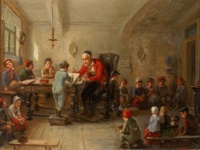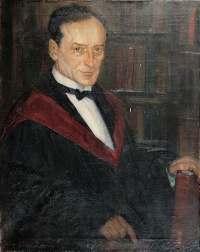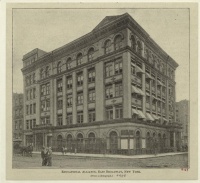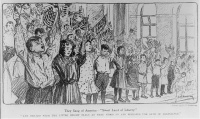From The Peopling of New York City
Contents |
Going to School
Religious Schooling
Since the early days of immigration, Jews always held education in high regard. During the late 19th century, when Jewish residents had just recently arrived, their idea of education was religious training for their children. There were not many options for recent immigrants as they opted to keep their children out of the public education system. One of the first forms of religious education was the heder, or Hebrew school. The heder was usually run by a melamed, or elementary-school teacher, out of a basement or tenement flat. [1] This education proved to be inefficient and cultural leaders quickly acted to establish a better way of providing Jewish education to the youth. This resulted in the establishment of community-organized yeshivas and Talmud Torah schools around the 1920’s.[1] These new institutions offered young Jews a better opportunity to attain a Jewish education.
Secular Education
Public Education
Regarding academics, the public school system was the best chance for young immigrants to obtain an education. The Jewish group was considered the most enthusiastic towards learning and education. This was perhaps due to belief by parents that education would lead to better jobs and upward mobility. Universities like Columbia, Hunter College, and the City College of New York (CCNY) were attractive destinations for those who sought to pursue professional careers. Perhaps one of the brightest Jewish, immigrant minds to attend CCNY at the turn of the century was Morris Raphael Cohen of the Class of 1900. Cohen was a philosopher and legal scholar that studied and later taught at CCNY. [1]
The Jewish desire for advancement through education came under trial when both Columbia and New York universities placed enrollment quotas for Jewish students. This occurred during the 1920’s partly due to the large number of Jewish applicants but mostly because of growing anti-Semitic and nativist feelings in the United States. However, in the 1940’s-50’s, ethnic organizations as well as the government placed pressure on academic institutions to end discrimination in enrollment based on race or ethnicity. After these quotas were dropped, Jews were able to continue to pursue professional careers. [2]
Educational Alliance
Other opportunities for education were offered by various institutions set for the purpose of educating and 'assimilating' the newly arrived immigrants and their children. Among these was the Education Alliance; which was created from a merging of the Hebrew Free School, the Young Men's Hebrew Association, and the Aguilar Free Library Association in 1889.[1] Although the institution was mostly started with the intention of 'Americanizing' the East European Jews, the whole community benefited much more from it. Some of its activities included English classes for adults, prep classes for young children about to enter public school, art and music classes, hygiene education, literature, among other numerous activities. Masses of immigrants flocked to the building that was located on East Broadway and Jefferson street to take advantage of the opportunities for education that the Alliance offered. The Educational Alliance was one of such institutions that really help young immigrants progress and make the assimilation process easier.[1]
References
- ↑ 1.0 1.1 1.2 1.3 1.4 Howe, Irving. World of Our Fathers. New York: Harcourt Brace Jovanovich, 1976.
- ↑ Binder, Frederick, and David Reimers. All The Nations Under Heaven. New York: Columbia UP, 1995.



